ANDYBROUWER.CO.UK
CAMBODIA
TALES 1998
Tuol
Sleng - Re-visiting the past
Tuol Sleng is already firmly
established on the fledgling tourist route in Phnom Penh. This is
a report from my visit in March 1998 to a place known to factory
staff working nearby at the time as 'konlaenh choul min dael
chenh' (or "the place where people went in but never came
out"). Following the Khmer Rouge occupation of Phnom Penh in
1975, they turned the former school, known at different times as
either the Lycee Chau Ponhea Yat or Tuol Svay Prey High School,
into Democratic Kampuchea's premier incarceration facility,
recognised and supported at the highest levels of the Khmer Rouge
hierarchy.
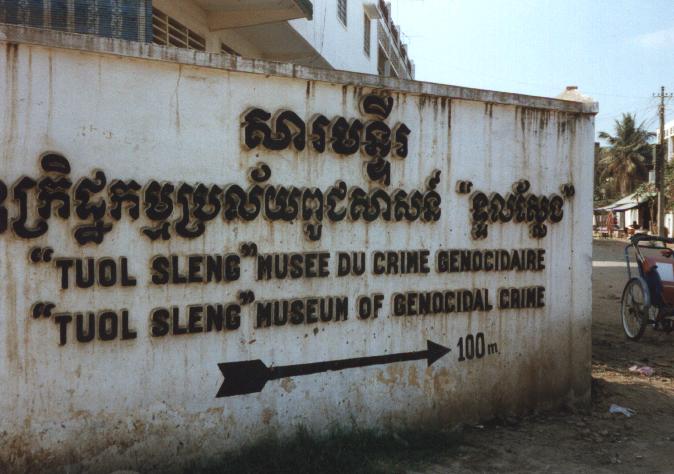 Aptly translated as "Hill of the Poison
Tree", Tuol Sleng is located in the southern suburbs of the
capital. Negotiating our way around the pot-holed backstreets, we
turned into 113 Street at the signpost marked Tuol Sleng - Museum
of Genocidal Crime. I hopped off the back of Onphum's moto,
swiftly side-stepped two disabled beggars in military fatigues at
the gate and walked into the former school compound. Parting with
my $2 admission fee, I declined the offer of a tour guide. It
wasn't my first visit to the torture and execution centre and on
this occasion, I wanted to wander around at my own pace and in my
own time. Tuol Sleng, more commonly known to the Khmer Rouge as
S-21, was at the hub of a sophisticated network of jails, prisons
and extermination centres spread across the country. In just 3
years 8 months and 20 days, in excess of 1.7 million Cambodians
died under the regime of Pol Pot and his crackpot cohorts. In
Tuol Sleng alone, more than 17,000 people are believed to have
been systematically imprisoned, interrogated, tortured and
murdered by a group of sadistic captors, hell bent on extracting
ficticious confessions to imaginary crimes, eventually devouring
their own kind in a killing frenzy of freightening proportions.
Aptly translated as "Hill of the Poison
Tree", Tuol Sleng is located in the southern suburbs of the
capital. Negotiating our way around the pot-holed backstreets, we
turned into 113 Street at the signpost marked Tuol Sleng - Museum
of Genocidal Crime. I hopped off the back of Onphum's moto,
swiftly side-stepped two disabled beggars in military fatigues at
the gate and walked into the former school compound. Parting with
my $2 admission fee, I declined the offer of a tour guide. It
wasn't my first visit to the torture and execution centre and on
this occasion, I wanted to wander around at my own pace and in my
own time. Tuol Sleng, more commonly known to the Khmer Rouge as
S-21, was at the hub of a sophisticated network of jails, prisons
and extermination centres spread across the country. In just 3
years 8 months and 20 days, in excess of 1.7 million Cambodians
died under the regime of Pol Pot and his crackpot cohorts. In
Tuol Sleng alone, more than 17,000 people are believed to have
been systematically imprisoned, interrogated, tortured and
murdered by a group of sadistic captors, hell bent on extracting
ficticious confessions to imaginary crimes, eventually devouring
their own kind in a killing frenzy of freightening proportions.
 Still only
8am, the complex was empty and very still. As I approached
A-block, the first of four, three-storey concrete buildings
housing the exhibits, I paused at the white-washed graves of
S-21's final fourteen victims. They had died in the last hours
before the Vietnamese liberation forces drove the Khmer Rouge
from Phnom Penh on 7 January 1979. Each of the ten rooms on the
ground floor of A-block was an interrogation unit for important
prisoners. The former classrooms now house a rusting metal
bedframe, manacles, a latrine box and scraps of clothing. On the
patterned tile floor, still clearly visible, are dried blood
stains. The back wall of each room carries an enlarged photograph
showing a mutilated corpse chained to the bedstead; these
pictures were taken by the liberating Vietnamese on their
arrival. Shafts of bright sunlight filtering through the barred
windows illuminate the rooms, whilst outside a group of small
children play oblivious to the horrors that once took place in
their playground.
Still only
8am, the complex was empty and very still. As I approached
A-block, the first of four, three-storey concrete buildings
housing the exhibits, I paused at the white-washed graves of
S-21's final fourteen victims. They had died in the last hours
before the Vietnamese liberation forces drove the Khmer Rouge
from Phnom Penh on 7 January 1979. Each of the ten rooms on the
ground floor of A-block was an interrogation unit for important
prisoners. The former classrooms now house a rusting metal
bedframe, manacles, a latrine box and scraps of clothing. On the
patterned tile floor, still clearly visible, are dried blood
stains. The back wall of each room carries an enlarged photograph
showing a mutilated corpse chained to the bedstead; these
pictures were taken by the liberating Vietnamese on their
arrival. Shafts of bright sunlight filtering through the barred
windows illuminate the rooms, whilst outside a group of small
children play oblivious to the horrors that once took place in
their playground.
At the end of the block, I
squeezed through a small opening and into the dusty stairway to
the first floor balcony. Both this and the next floor contain
five larger cells each. These were used as detention rooms where
between 50-100 prisoners were shackled in leg irons for days on
end waiting for their inevitable turn at the hands of the
interrogators. Nowadays, they see few visitors except for the
tiny birds flittering in and out of the broken louvred shutters
on the window. A solitary latrine box on the floor covered in
thick dust, numbers painted crudely on the wall and a blackboard
are the only signs of any former habitation. A notice on the
outside wall of A-block lists in both Khmer and English, the
security regulations to which each prisoner had to adhere or
suffer dire consequences. The rules were chalked up on the
noticeboards within the mass detention cells and translated,
read:
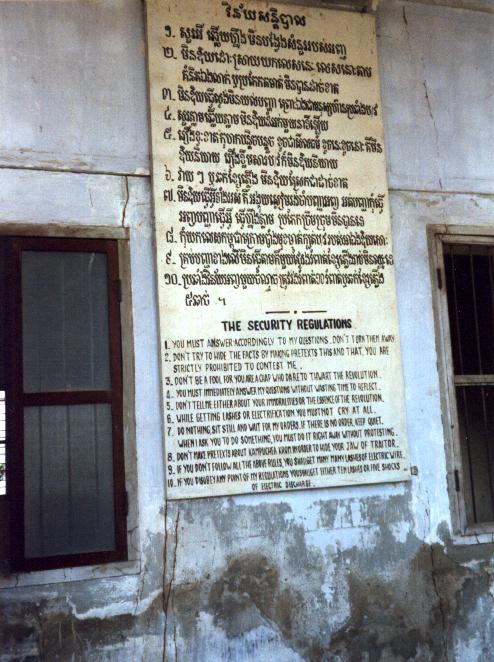 1. You must answer accordingly to my
questions - don't turn them away.
1. You must answer accordingly to my
questions - don't turn them away.
2. Don't try to hide the facts by
making pretexts this and that. You are strictly prohibited to
contest me.
3. Don't be a fool for you are a
chap who dare thwart the revolution.
4. You must immediately answer my
questions without wasting time to reflect.
5. Don't tell me either about your
immoralities or the essence of the revolution.
6. While getting lashes or
electrification you must not cry at all.
7. Do nothing, sit still and wait
for my orders. If there is no order, keep quiet. When I ask you
to do something, you must do it right away without protesting.
8. Don't make pretexts about
Kampuchea Krom in order to hide your jaw of traitor.
9. If you don't follow all the
above rules, you will get many lashes of electric wire.
10. If you disobey any point of my
regulations you shall get either ten lashes or five shocks of
electric discharge.
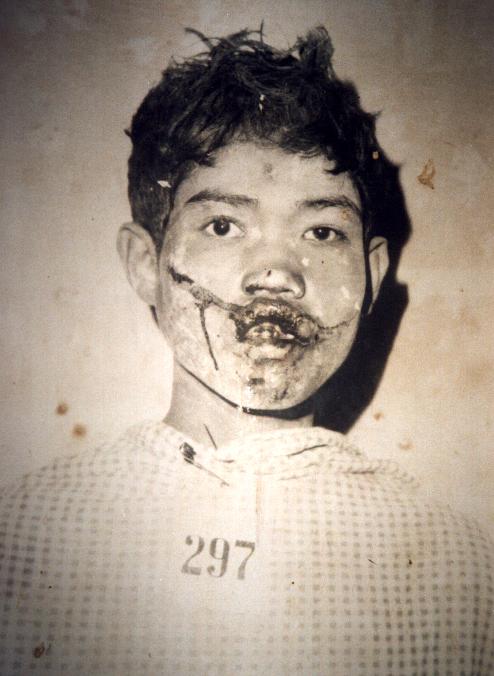 Before entering B-block, I stopped at the
hanging bar and two large earthernware jars on the edge of the
grassy courtyard. Both were used as part of the interrogators'
range of techniques to extract confessions, either by hanging the
prisoner by his arms or repeatedly ducking the victim into a jar
full of water head first. Personally, I found B-block the most
chilling and compelling part of the whole exhibition. Put simply,
you enter a world where everybody was condemned to death. The
walls of the ground floor are covered by thousands of black and
white face photographs of helpless victims, looking out on the
same rooms where they were most likely tortured. The Khmer Rouge
were nothing, if not meticulous. Each prisoner was numbered and
photgraphed on arrival. Many were then pictured at the point of
death or immediately after. The photographs on display include
men, women and children. Lots of children. Some of the victims
force a smile, others appear confused while most display an
almost tangible fear of the unknown. A boy with his mouth
bloodied and swollen (left). A woman stares blankly at the
camera, while the tiny hand of an infant grips her sleeve. A boy
with a heavy metal chain around his neck, has the number 1 pinned
to his shirt. A youth stands with his hands tied behind his back,
untroubled by the safety pin that fastens his number into the
flesh of his bare chest. And thousands more.
Before entering B-block, I stopped at the
hanging bar and two large earthernware jars on the edge of the
grassy courtyard. Both were used as part of the interrogators'
range of techniques to extract confessions, either by hanging the
prisoner by his arms or repeatedly ducking the victim into a jar
full of water head first. Personally, I found B-block the most
chilling and compelling part of the whole exhibition. Put simply,
you enter a world where everybody was condemned to death. The
walls of the ground floor are covered by thousands of black and
white face photographs of helpless victims, looking out on the
same rooms where they were most likely tortured. The Khmer Rouge
were nothing, if not meticulous. Each prisoner was numbered and
photgraphed on arrival. Many were then pictured at the point of
death or immediately after. The photographs on display include
men, women and children. Lots of children. Some of the victims
force a smile, others appear confused while most display an
almost tangible fear of the unknown. A boy with his mouth
bloodied and swollen (left). A woman stares blankly at the
camera, while the tiny hand of an infant grips her sleeve. A boy
with a heavy metal chain around his neck, has the number 1 pinned
to his shirt. A youth stands with his hands tied behind his back,
untroubled by the safety pin that fastens his number into the
flesh of his bare chest. And thousands more.
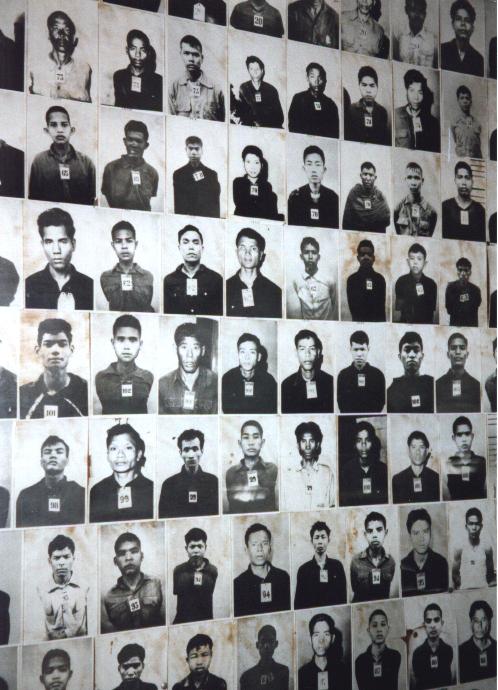 As you enter B-block, the first room
contains the photographer's chair, a pile of victim's clothes and
mug-shots of five of the Westerners captured, tortured and killed
at the prison, alongwith the confession from an American sailor,
James Clark. Also on display are pictures of Hu Nim, the Minister
of Information and the most prominent Khmer Rouge official killed
at Tuol Sleng, S-21's interrogators, guards and cooks and the
prison chief, a former schoolteacher named Duch. In another
photo, Duch poses alongwith other members of the S-21 hierarchy
and their wives and children. All the other rooms display row
upon row of face photographs. Some of the victims bear bruises
from recent beatings, others are crying, most appear exhausted. A
few victims have been identified and their name has been scrawled
across the picture but most remain anonymous witnesses to their
own fate. Also on show are a few prints of naked and mutilated
corpses, frozen in their final agonising moments, which the S-21
warders used as proof of the success of their work to the party
hierarchy.
As you enter B-block, the first room
contains the photographer's chair, a pile of victim's clothes and
mug-shots of five of the Westerners captured, tortured and killed
at the prison, alongwith the confession from an American sailor,
James Clark. Also on display are pictures of Hu Nim, the Minister
of Information and the most prominent Khmer Rouge official killed
at Tuol Sleng, S-21's interrogators, guards and cooks and the
prison chief, a former schoolteacher named Duch. In another
photo, Duch poses alongwith other members of the S-21 hierarchy
and their wives and children. All the other rooms display row
upon row of face photographs. Some of the victims bear bruises
from recent beatings, others are crying, most appear exhausted. A
few victims have been identified and their name has been scrawled
across the picture but most remain anonymous witnesses to their
own fate. Also on show are a few prints of naked and mutilated
corpses, frozen in their final agonising moments, which the S-21
warders used as proof of the success of their work to the party
hierarchy.
Although I was unable to gain
access to the first floor rooms, they contain gruesome evidence
of the crimes perpetrated at Tuol Sleng. In a hurry to leave, the
Khmer Rouge left behind tens of thousands of pages of
incriminating material, together with 7,000 photographic
negatives. Meticulously, the S-21 interrogators had obtained
signed confessions from most of their victims and also kept
extensive records of all new arrivals, daily execution schedules
as well as torture manuals and records. At any one time, the
prison held between 1,000-1,500 prisoners. They were repeatedly
tortured and coerced into naming family members and close
associates, who were in turn arrested, tortured and killed. In
the early months of S-21's existence, most of the victims were
from the previous Lon Nol regime and included soldiers,
government officials, as well as academics, doctors, teachers,
students, factory workers, monks, engineers, etc. Later, the
party leadership's paranoia turned on its own ranks and purges
throughout the country saw thousands of party activists and their
families brought to Tuol Sleng and liquidated. Although many died
under torture and were buried in shallow mass graves in the
prison grounds, the majority of the 17,000 victims processed
through S-21 were trucked at night to Choeung Ek, 15 kilometres
outside of the city, forced to dig their own graves before being
killed by a blow to the back of the head with a pickaxe or hoe to
avoid wasting precious ammunition.
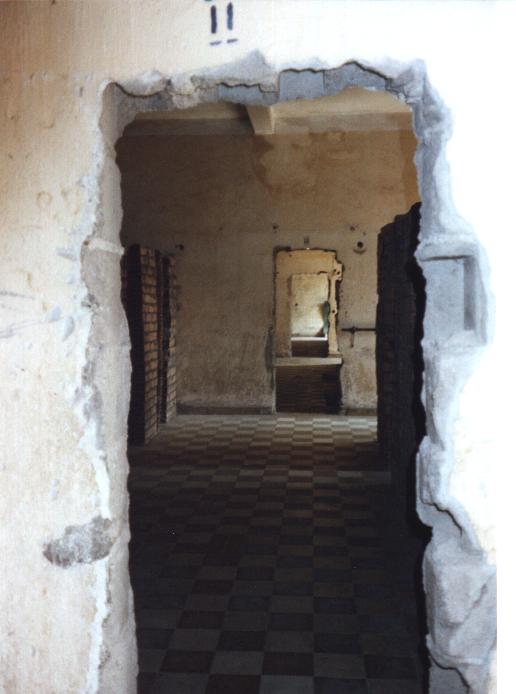 Onto C-block
with its barbed wire frontage to prevent potential suicides. The
ground floor classrooms are subdivided up into tiny crude cells
by short brick walls about seven foot high, where prisoners were
held during interrogation. In some cells, manacles and leg irons
remain alongside small ammunition boxes that doubled up as
latrine cans. Squeezing through the padlocked gate to the
stairway, I found that the first floor cells are of a wooden
construction but equally cramped, whilst the next level was used
for mass detention, although both floors are usually off-limits
to visitors. In the courtyard in front of C-block, a wooden
memorial stupa, erected in 1984 to commemorate the victims of
Tuol Sleng, had recently been dismantled. I also noticed that
families of squatters had disappeared from the rear of C-block
and a new boundary wall had been erected to prevent their return.
Improvement work was also taking place to the metal fence topped
with barbed wire at the front of the compound.
Onto C-block
with its barbed wire frontage to prevent potential suicides. The
ground floor classrooms are subdivided up into tiny crude cells
by short brick walls about seven foot high, where prisoners were
held during interrogation. In some cells, manacles and leg irons
remain alongside small ammunition boxes that doubled up as
latrine cans. Squeezing through the padlocked gate to the
stairway, I found that the first floor cells are of a wooden
construction but equally cramped, whilst the next level was used
for mass detention, although both floors are usually off-limits
to visitors. In the courtyard in front of C-block, a wooden
memorial stupa, erected in 1984 to commemorate the victims of
Tuol Sleng, had recently been dismantled. I also noticed that
families of squatters had disappeared from the rear of C-block
and a new boundary wall had been erected to prevent their return.
Improvement work was also taking place to the metal fence topped
with barbed wire at the front of the compound.
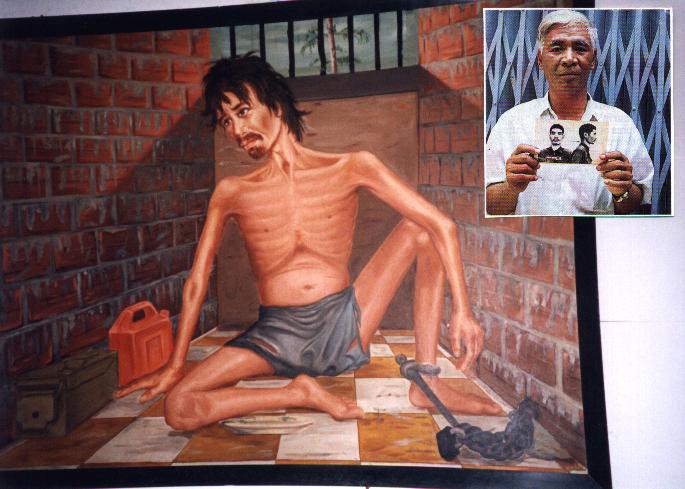 The final exhibit building, D-block, holds
a collection of paintings, photographs and other items and was
used for mass detention under the Khmer Rouge. As I approached, I
recognised my guide from my last visit to Phnom Penh, Samnang,
who immediately pumped my hand with a firm handshake and asked
about my health and family. Although the location wasn't ideal,
he seemed genuinely pleased to renew our acquaintance, albeit
briefly, and I likewise. As with the rest of the complex, I
wandered through D-block alone and could not fail to be struck by
the graphic colour paintings that line the walls. Only seven
prisoners are known to have survived S-21 and they were only kept
alive because they had skills that proved useful to their
captors. Vann Nath was an artist, who'd been held at the centre for
exactly one year and had painted oil portraits of Pol Pot. He
returned after the liberation to paint a series of scenes,
fifteen in all, including this self portrait, depicting the harsh
realities of life and death at Tuol Sleng including examples of
the torture methods employed there.
The final exhibit building, D-block, holds
a collection of paintings, photographs and other items and was
used for mass detention under the Khmer Rouge. As I approached, I
recognised my guide from my last visit to Phnom Penh, Samnang,
who immediately pumped my hand with a firm handshake and asked
about my health and family. Although the location wasn't ideal,
he seemed genuinely pleased to renew our acquaintance, albeit
briefly, and I likewise. As with the rest of the complex, I
wandered through D-block alone and could not fail to be struck by
the graphic colour paintings that line the walls. Only seven
prisoners are known to have survived S-21 and they were only kept
alive because they had skills that proved useful to their
captors. Vann Nath was an artist, who'd been held at the centre for
exactly one year and had painted oil portraits of Pol Pot. He
returned after the liberation to paint a series of scenes,
fifteen in all, including this self portrait, depicting the harsh
realities of life and death at Tuol Sleng including examples of
the torture methods employed there.
 More
photographs depict the arrival of the victorious Khmer Rouge in
the capital, whilst others show numerous mass grave sites exhumed
around the country after their defeat in early 1979. A variety of
implements are on display, amongst them wooden water tanks and
beds, overlooked by paintings illustrating their actual use as
torture techniques. One room contains a few head and shoulder
busts of Pol Pot together with their casts, discarded portraits,
leg irons, chains and manacles and a series of wall maps. In the
final room, perhaps the most controversial exhibit at Tuol Sleng
stuns most visitors into an uneasy silence. On the wall, fifteen
feet square in size, is a map of Cambodia fashioned entirely out
of over 200 skulls of victims found in shallow graves within the
complex. The authorities have so far resisted calls to lay these
particular victims to rest rather than use them as a permanent
reminder of Khmer Rouge atrocities. A notice next to the map
suggests that 3,314,768 people died as a result of their regime,
although recent research suggests a more conservative figure of
around 1.7 million. A single storey wooden building, housing the
museum offices, guide's quarters and toilets, also has a small
gift shop open for business. As I left for the moto ride to the
'killing fields' of Choeung Ek, I couldn't help thinking that
whilst Tuol Sleng isn't everyone's ideal memorial, it is
nevertheless an important symbol of the crimes perpetrated by Pol
Pot and his murderous henchmen that has so affected the psyche of
the Cambodian people for the past twenty years.
More
photographs depict the arrival of the victorious Khmer Rouge in
the capital, whilst others show numerous mass grave sites exhumed
around the country after their defeat in early 1979. A variety of
implements are on display, amongst them wooden water tanks and
beds, overlooked by paintings illustrating their actual use as
torture techniques. One room contains a few head and shoulder
busts of Pol Pot together with their casts, discarded portraits,
leg irons, chains and manacles and a series of wall maps. In the
final room, perhaps the most controversial exhibit at Tuol Sleng
stuns most visitors into an uneasy silence. On the wall, fifteen
feet square in size, is a map of Cambodia fashioned entirely out
of over 200 skulls of victims found in shallow graves within the
complex. The authorities have so far resisted calls to lay these
particular victims to rest rather than use them as a permanent
reminder of Khmer Rouge atrocities. A notice next to the map
suggests that 3,314,768 people died as a result of their regime,
although recent research suggests a more conservative figure of
around 1.7 million. A single storey wooden building, housing the
museum offices, guide's quarters and toilets, also has a small
gift shop open for business. As I left for the moto ride to the
'killing fields' of Choeung Ek, I couldn't help thinking that
whilst Tuol Sleng isn't everyone's ideal memorial, it is
nevertheless an important symbol of the crimes perpetrated by Pol
Pot and his murderous henchmen that has so affected the psyche of
the Cambodian people for the past twenty years.
Postscript - May 1999:
Duch, the former director of Tuol Sleng and the Khmer Rouge's
chief executioner, has surfaced in Battambang and admitted his
part in the genocide of the 1970s. Now known as Ta Pin (real name
Kiang Khek Iev), he runs a shop selling snacks and gasoline in a
small hamlet and has converted to Christianity. Living in a
border refugee camp for much of the 1980s, he's worked with
international aid groups in recent years but has only just
revealed his real identity to reporters Nic Dunlop and Nate
Thayer from the magazine, Far Eastern Economic Review.
Responsible for the deaths of at least 17,000 people at Tuol
Sleng, 56-year old Duch is now under arrest and will become a key
witness in the forthcoming trial of imprisoned Khmer Rouge
military chief Ta Mok and any future proceedings against other
Khmer Rouge figureheads like Khieu Samphan, Nuon Chea and Ieng
Sary.
June - 1999: In
what was seen as a test case for Cambodia's judicial system,
Khmer Rouge commander Nuon Paet has been sentenced to life
imprisonment for the murder of three tourists, David Wilson,
Jean-Michel Braquet and Briton, Mark Slater. The backpackers were
abducted in July 1994 when Khmer Rouge soldiers attacked a train
between Phnom Penh and Sihanoukville and were then killed three
months later when negotiations for their release broke down. The
Government are now considering whether to prosecute two former
colleagues of Nuon Paet, Chhouk Rin and Sam Bith, who gave
evidence at the trial and who were also involved in the kidnap.
Both are currently serving Royal Cambodian Armed Forces (RCAF)
officers following their defection from the Khmer Rouge rank and
file. Meanwhile, still in custody and awaiting trial are Chhit
Choeun, more commonly known as the notorious Ta Mok, arrested in
March and the former Tuol Sleng/S-21 chief, Duch. Both are at the
centre of a tug-of-war between the United Nations and the
Cambodian authorities over the style of trial they should face.
Cambodia Tales : Messageboard : Next : E-mail
The contents of this website cannot be
reproduced or copied without permission of the site author. © Andy Brouwer 2006
 Aptly translated as "Hill of the Poison
Tree", Tuol Sleng is located in the southern suburbs of the
capital. Negotiating our way around the pot-holed backstreets, we
turned into 113 Street at the signpost marked Tuol Sleng - Museum
of Genocidal Crime. I hopped off the back of Onphum's moto,
swiftly side-stepped two disabled beggars in military fatigues at
the gate and walked into the former school compound. Parting with
my $2 admission fee, I declined the offer of a tour guide. It
wasn't my first visit to the torture and execution centre and on
this occasion, I wanted to wander around at my own pace and in my
own time. Tuol Sleng, more commonly known to the Khmer Rouge as
S-21, was at the hub of a sophisticated network of jails, prisons
and extermination centres spread across the country. In just 3
years 8 months and 20 days, in excess of 1.7 million Cambodians
died under the regime of Pol Pot and his crackpot cohorts. In
Tuol Sleng alone, more than 17,000 people are believed to have
been systematically imprisoned, interrogated, tortured and
murdered by a group of sadistic captors, hell bent on extracting
ficticious confessions to imaginary crimes, eventually devouring
their own kind in a killing frenzy of freightening proportions.
Aptly translated as "Hill of the Poison
Tree", Tuol Sleng is located in the southern suburbs of the
capital. Negotiating our way around the pot-holed backstreets, we
turned into 113 Street at the signpost marked Tuol Sleng - Museum
of Genocidal Crime. I hopped off the back of Onphum's moto,
swiftly side-stepped two disabled beggars in military fatigues at
the gate and walked into the former school compound. Parting with
my $2 admission fee, I declined the offer of a tour guide. It
wasn't my first visit to the torture and execution centre and on
this occasion, I wanted to wander around at my own pace and in my
own time. Tuol Sleng, more commonly known to the Khmer Rouge as
S-21, was at the hub of a sophisticated network of jails, prisons
and extermination centres spread across the country. In just 3
years 8 months and 20 days, in excess of 1.7 million Cambodians
died under the regime of Pol Pot and his crackpot cohorts. In
Tuol Sleng alone, more than 17,000 people are believed to have
been systematically imprisoned, interrogated, tortured and
murdered by a group of sadistic captors, hell bent on extracting
ficticious confessions to imaginary crimes, eventually devouring
their own kind in a killing frenzy of freightening proportions.





